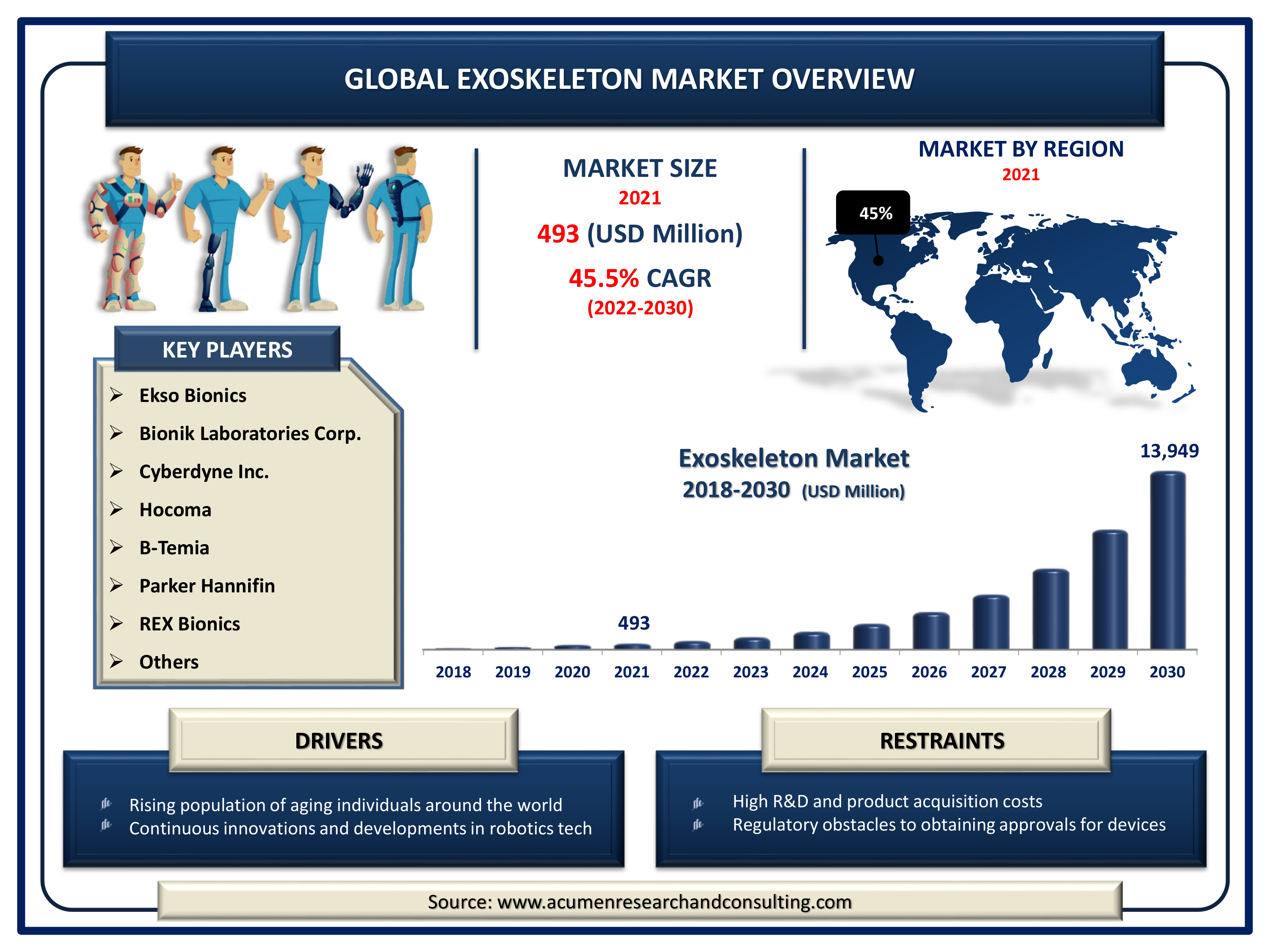Exoskeleton Market | Acumen Research and Consulting
Exoskeleton Market Size - Global Industry Share, Analysis, Trends and Forecast 2022 - 2030
Published :
Report ID:
Pages :
Format : ![]()
The Global Exoskeleton Market Size Accounted for USD 493 Million in 2021 and is predicted to be worth USD 13,949 Million by 2030, with a CAGR of 45.5% during the Forthcoming Period from 2022 to 2030.

The growing demand for robotics wearable technology in rehabilitation centers, combined with rising industrial activity globally, is driving the exoskeletons market size. Another factor contributing to the expansion of the exoskeletons market share is the advancement of motor-equipped robotic arms to aid human body fundamentals. According to the exoskeletons market forecast, the rising prevalence of heart attacks, spinal cord injuries, and paralysis among patients has also fuelled demand for exoskeletons in the healthcare industry over the next few years.
Exoskeletons are wearable robotics devices that help the user increase strength and functionality in a variety of ways. Exoskeletons are amplifiers that are placed on the user's body to reinforce, augment, or rebuild a physical movement. Wearable exoskeletons are electrical and mechanical systems that help, enhance, or improve movement and mobility in a wide range of human movement applications and circumstances. The applications encompass a broad range of domains, such as medical equipment for patient rehabilitation therapy trying to recover from trauma, motion aids for disabled people, home healthcare robots for offering human daily assistance, and the reduction of physical burden in military and industrial applications.
Global Exoskeleton Market Analysis
Market Drivers
- The rising population of aging individuals around the world
- increasing numbers of people with Parkinson's and other muscle-related illnesses
- Growing demand for robotic rehabilitation in the healthcare sector
- Continuous innovations and developments in robotics technology
- Significant investments in the development of exoskeleton technology
Market Restraints
- High R&D and product acquisition costs
- Regulatory obstacles to obtaining approvals for medical exoskeleton applications
Market Opportunities
- Rising adoption of human augmentation devices in military and industrial sectors
- Increasing insurance coverage for exoskeletons
Exoskeleton Market Report Coverage:
| Market | Exoskeleton Market |
| Exoskeleton Market Size 2021 | USD 493 Million |
| Exoskeleton Market Forecast 2030 | USD 13,949 Million |
| Exoskeleton Market CAGR During 2022 - 2030 | 45.5% |
| Exoskeleton Market Analysis Period | 2018 - 2030 |
| Exoskeleton Market Base Year | 2021 |
| Exoskeleton Market Forecast Data | 2022 - 2030 |
| Segments Covered | By Mobility, By Technology, By Extremity, By End-use, And By Region |
| Exoskeleton Market Regional Scope | North America, Europe, Asia Pacific, Latin America, and Middle East & Africa |
| Key Companies Profiled | Bionik Laboratories Corp., Ekso Bionics, Cyberdyne Inc., Hocoma, B-Temia, Hyundai Motor Company, Lockheed Martin Corporation, Parker Hannifin, REX Bionics, Levitate Technologies, Inc., Ottobock SE & Co. KGaA, and ReWalk Robotics |
| Report Coverage |
Market Trends, Drivers, Restraints, Competitive Analysis, Player Profiling, Regulation Analysis |
The rising demand for orthopedic rehabilitation in the healthcare industry, the growing occurrence of cerebrovascular accidents, and the increasing expenditure on the exoskeleton in the military and defense sectors are driving growth in the exoskeleton market size. Furthermore, the substitution of traditional prosthetic devices with exoskeleton innovation, as well as the growing adoption of human augmentation in advanced manufacturing and other end-use sectors, present considerable potential for the exoskeleton market value. The aging population has contributed to an increase in demand for physical therapist services in recent years. The increased rate of recovery from physical illnesses such as stroke has emphasized the significance of technology in healthcare. As a result, robotic rehabilitation, as well as adaptive equipment, promise to alleviate anxiety among physiotherapy staff, reduce operation, and improve patients' quality of life.
However, strict government regulations related to medical application domains are the key factor restricting the exoskeleton market growth to a certain extent.
Exoskeleton Market Segmentation
The global exoskeleton market segmentation is based on the mobility, technology, extremity, end-use, and geographical region.
Market by Mobility
- Mobile
- Fixed/Stationary

In terms of mobility, the mobile segment held the greatest market share in 2021. This significant exoskeleton market share and profitable growth rate can be attributed to an increase in demand for motor-equipped robotic systems to assist users' body mechanics as well as an increase in activities for research and development. Furthermore, the availability of favorable reimbursement initiatives encouraging the acceptance of exoskeleton technology solutions in emerging countries and developing countries is actively contributing to the segment's growth and development.
Market by Technology
- Powered
- Passive
In terms of technology, the powered segment will dominate the market in 2021. This expansion is due to the increasing use of powered exoskeleton options in a wide range of industries to improve personal productivity and safety. Furthermore, powered technological solutions provide easier lifting movement, less strain on the user's body, force multiplier, increased strength, and increased productivity.
Market by Extremity
- Full Body
- Upper Body
- Lower Body

According to the Exoskeleton industry analysis, the lower body segment is expected to grow significantly in the market over the next few years. This growth is due to the dramatic increase in lower body handicaps and the increasing use of exoskeleton products for mobility, stability, as well as weight-bearing functionality by paralyzed and elderly populations. Furthermore, such lower body systems are widely used by military and defense professionals to aid army personnel or improve their speed and coverage. Moreover, lower-body wearables are used to offer mobility to individuals who are disabled in the healthcare channel, which is the biggest platform in the exoskeleton market trend.
Market by End-use
- Industrial
- Military
- Healthcare
- Others
Based on the end-user, the healthcare industry held the largest market share and is predicted to hold more than half of it in 2021. The increasing prevalence of spinal cord injuries, the widespread use of such solutions and products in rehabilitation facilities, and the sharp rise in the number of people receiving therapies are among the main factors causing this growth. Furthermore, a growing percentage of regulatory government approvals and increased awareness of technically sophisticated systems are driving demand for and incorporation of exoskeleton solutions in the healthcare sector.
Exoskeleton Market Regional Outlook
North America
- U.S.
- Canada
Europe
- U.K.
- Germany
- France
- Spain
- Rest of Europe
Latin America
- Mexico
- Brazil
- Rest of Latin America
Asia-Pacific
- India
- Japan
- China
- Australia
- South Korea
- Rest of Asia-Pacific
The Middle East & Africa (MEA)
- Gulf Cooperation Council (GCC)
- South Africa
- Rest of the Middle East & Africa
Growing use of Exoskeletons in Military and Defense Industries in North America, Propels Regional Market Growth
Geographically, the North America region is expected to be the prominent region in the market. This is due to an increase in the number of disabled individuals, increased spending on research efforts, increased private and public endorse, a rise in the number of collaborations and partnerships among major players, and the accessibility of advanced technologies. Furthermore, the rapidly expanding geriatric population, increasing disposable income, private and government investor accessibility, and increasing human strengthening in manufacturing and military verticals are boosting the exoskeleton market growth in North America. Furthermore, increased company funding and subsidies for innovative products, steadily increasing buying power parity, and the presence of major companies providing funds and assistance for the growth of advanced technology products are all contributing to the exoskeleton market revenue growth.
Exoskeleton Market Players
Some of the prominent global exoskeleton market companies are Bionik Laboratories Corp., Ekso Bionics, Cyberdyne Inc., Hocoma, B-Temia, Hyundai Motor Company, Lockheed Martin Corporation, Parker Hannifin, REX Bionics, Levitate Technologies, Inc., Ottobock SE & Co. KGaA, and ReWalk Robotics
Frequently Asked Questions
How much was the global exoskeleton market size in 2021?
The global exoskeleton market size in 2021 was accounted to be USD 493 Million.
What will be the projected CAGR for global exoskeleton market during forecast period of 2022 to 2030?
The projected CAGR of exoskeleton during the analysis period of 2022 to 2030 is 45.5%.
Which are the prominent competitors operating in the market?
The prominent players of the global exoskeleton market involve Bionik Laboratories Corp., Ekso Bionics, Cyberdyne Inc., Hocoma, B-Temia, Hyundai Motor Company, Lockheed Martin Corporation, Parker Hannifin, REX Bionics, Levitate Technologies, Inc., Ottobock SE & Co. KGaA, and ReWalk Robotics.
Which region held the dominating position in the global exoskeleton market?
North America held the dominating share for exoskeleton during the analysis period of 2022 to 2030.
Which region exhibited the fastest growing CAGR for the forecast period of 2022 to 2030?
Asia-Pacific region exhibited fastest growing CAGR for exoskeleton during the analysis period of 2022 to 2030.
What are the current trends and dynamics in the global exoskeleton market?
Increasing numbers of people with Parkinson's and other muscle-related illnesses and growing demand for robotic rehabilitation in the healthcare sector are the prominent factors that fuel the growth of global exoskeleton market.
By mobility segment, which sub-segment held the maximum share?
Based on mobility, mobile segment hold the maximum share for exoskeleton market in 2021.


